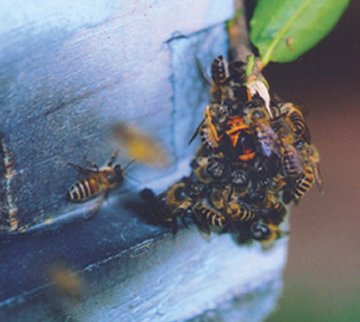Bee heat cooks invaders
Certain honeybees in Asia use their body heat to kill attacking wasps.
By Emily Sohn
Have you ever noticed how warm you get at concerts, street fairs, and other big-crowd events? Body heat from all those people really adds up.
Body heat can be so powerful that some honeybees in Asia use it as a deadly weapon. A few dozen bees sometimes swarm around attacking wasps and heat them to death.

The bees that collect into a ball to kill a wasp or some other invader seem to regulate how hot it gets to keep from cooking themselves, says an international team of scientists. The team studied this heat-balling behavior in two species of honeybees. One species is native to Asia. The other species, the European honeybee, was brought to Asia about 50 years ago.
Heat balling is a defense mechanism used by honeybees against fierce wasps that break into beehives and nests in order to steal bee babies as food for the wasps’ own young. The wasps are as big as 5 centimeters (2 inches) from wingtip to wingtip, and researchers have seen a single wasp win battles against as many as 6,000 bees, when those bees are of a type that doesn’t make heat balls to defend themselves.
To further study this defense behavior, the scientists tied down 12 wasps and moved one wasp close to each of six colonies of European bees and six colonies of Asian bees. All of the defender bees from each colony surrounded its wasp immediately. The researchers then used a special sensor to measure temperatures inside the bee clumps.
Within 5 minutes, the temperature at the center of an average ball rose to around 45 degrees C (113 degrees F). That’s high enough to kill a wasp.
In separate tests, the researchers checked to see how close the bees came to cooking themselves. There’s a margin of safety, they say. Asian honeybees die at 50.7 degrees C (123 degrees F) and European honeybees die at 51.8 degrees C (125 degrees F).
Native Asian bees have better heat-balling tactics than the European imports do, the scientists found. The native bees gather one and a half times as many individuals in their swarms as the European bees do.
It makes sense that the Asian bees are better at fighting wasps, the researchers say. They and the Asian baby-snatching wasps have been enemies for thousands of years, lots of time for the bees to perfect their heat-balling technique.
Going Deeper:
Milius, Susan. 2005. Balls of fire: Bees carefully cook invaders to death. Science News 168(Sept. 24):197. Available at http://www.sciencenews.org/articles/20050924/fob5.asp .
You can learn about how honeybees use heat to attack a hornet at www.vespa-crabro.de/manda.htm (Vespa crabro).







